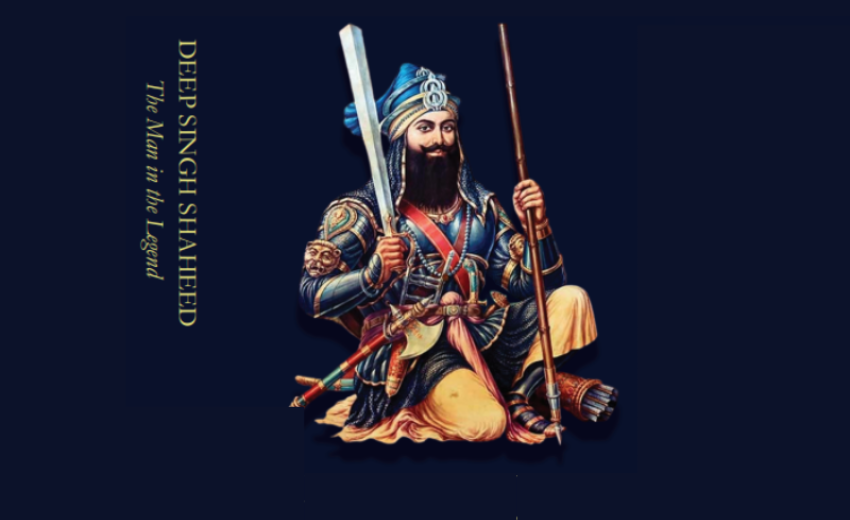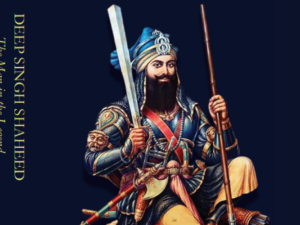Selected Excertps from Hari Simran Singh's new book: Deep Singh Shaheed - The Man in the Legend
Punjabi translation was released on 14 September at Guru Nanak Dev University.
Commenting on the period, Walker records in the ‘Gazetteer of the Lahore District’, how the fate of the region was tragically intertwined with that of Lahore, its provincial capital which had become ‘the point d’ appui [military base] of Sikh insurrections, and like a second Ariminum, the itar ad bella [route for invasion] of every invader from the West.’
In overthrowing a banefully oppressive regime, the Sikhs also stemmed the upcoming tide of invasions. That they prevailed in their prolonged life-and-death struggle against stupendous odds can be attributed to their having fortuitously achieved the Clausewitzian Trinity. Their unbending political objective, sovereignty, was clearly predicated; their operational instruments perfectly adapted to their context; and above all, their popular passions were powerfully articulated—chardi kala, moral ascendancy or unlimited optimism—as a social force.
‘They were few in number when opposed to the legions of their enemies; they were poor and of small repute if compared with their oppressors who commanded the whole resources of Hindustan. With nothing but their faith, their brave hearts and their swords, they engaged in a death-struggle with the Mughal Empire…[while] persecutions strengthened their obstinate attachment to their faith’ (Lepel Griffin).
_______________
The view was reminiscent of an idyllic oil-on-canvas pastoral. A dim haze of mist hung in the crisp morning air, gradually lifting under the winter sun. Sequestered between sugar cane and wheat fields, a pair of translucent-white oxen ran a cane press, their heads bobbing up and down to the rhythmic jingle of their cow-bells. Bhaga, popularly known as Bhagtu (holy man) for his religious bent, had been at work since early morning, leaning over the press to feed harvested sugar cane sticks between its metallic drums that conveyed the juice through a channel into a large steaming cauldron placed over a fire.
In mid-distance, another pair of oxen trod the earth in circular motion to drive a Persian wheel, irrigating wheat fields spread as far as the eye could see, a luminous emerald but with a hint of gold that presaged the onset of Spring.
Wafted across from the mangrove yonder came the caw and shriek of crows and parrots, heard just above the cacophony of cow-bells and the grating off-key moan of the cane press and the Persian wheel.
Rather used to working alone, it took Bhagtu some time to notice the presence of a stranger. Clad in his usual saffron, his hair tied above the head in a knot, staff in one hand and a brass water pot in the other, a sadhu (itinerant holy man) was not an uncommon sight in these parts. The two soon greeted each other and, as was his wont, Bhagtu promptly spread a cotton rug (durrie) on the ground and bade him to sit just when his wife, Jeoni, arrived with lunch for her husband. It was customary to offer food rather than alms to sadhus. Bhagtu and his wife waited upon him with much affection and solicitude as they served him a hearty meal.
Re-energized with wholesome food still warm from the hearth, the sadhu observed with some curiosity the absence of young helping hands.
‘Do you not have any children?’ he asked, his words half-muffled between munching and swallowing another morsel of unleavened flat corn bread and spinach dripping with makhan (white butter), a winter staple in the region.
No, responded Bhagtu despondently, adding how much they longed for progeny. At this, the sadhu quaffed the tall glass of lassi (butter-milk), paused, and then briefly went into a meditative trance. Shortly, with eyes half-closed in prayer, he invoked the Lord’s blessings.
________________
In a sense, the Khalsa carried echoes of the knights of European late Middle Ages who became associated with the ideals of chivalry and a code of conduct for the perfect courtly Christian warrior. The Khalsa baptismal ceremony was not without its parallels to the ‘accolade’, the knighting ceremony, that usually involved a ritual bath, prayer, oath-taking, and dubbing with the sword. For the Khalsa, the baptismal nectar was consecrated with a double-edged dagger because, with Guru Gobind Singh, the sword had taken on a special, almost divine signification when it was deified as Bhagauti (sublime energy). Just as God subdues enemies, so does the Sword.
______________
Trilok Singh describes Deep Singh’s raid on an Afghan column in some detail. Split into five groups of a hundred each on horseback, each trooper was armed with two swords, a lance, and assorted weapons tucked into their battledress. They posted their scouts atop trees and took positions in the undulating plains forested by kikar (babool) and tahli (North Indian rosewood) between Pipli-Thanesar and the Markanda river, awaiting the enemy.
Behind the escort that led the several miles long cavalcade were the main columns which they let pass, watching undetected from their coign of vantage a safe distance away. When the animals laden with the booty and bullock carts full of women-prisoners hove into view, at a signal from Deep Singh—halla! (Attack!)—they charged out of their hideouts in two groups. Achieving complete surprise, one group struck at the armed escorts while the other rounded up the bullock carts. At another signal from Deep Singh—haran! (Punjabi for ‘deer’; here implies ‘Flee like the deer!)—they drove these off into the wilderness, rescuing some 300 women prisoners in fourteen bullock-carts, and later escorting them back to their homes.
_____________
Jahan Khan expected a cavalry charge from the Sikhs as was their wont but he could never have anticipated that it would be directed at his own command-and-control center. The Sikhs launched two wings with elan, Naudh Singh attacking from the right and Dyal Singh from the left. Taken by surprise, when the enemy troops were unbalanced, it was the turn of Deep Singh and Balwant Singh to charge and to try to cut down the disintegrating mass.
Miskin’s account suggests that the Sikhs went straight for the jugular with frontal as well as flanking attacks to overwhelm the enemy by collapsing their front and flanks. The impression the enemy had was of being attacked from ‘all four sides.’ As part of Jahan Khan’s retinue, Miskin’s impression of being thus attacked and encircled is tenable.
Somewhat unprepared for the audacity of the Sikh offensive, the Lahore Army rallied and fought a successful defensive action under Jahan Khan, their veteran commander. Mounted on an elephant and backed by some spirited cavalry, in trying to rally his fleeing soldiers, Jahan Khan threatens, shames, and incites them to face the Singhs but his soldiers have no heart to combat so devoted and valiant a foe, far more skilled with the sword.


